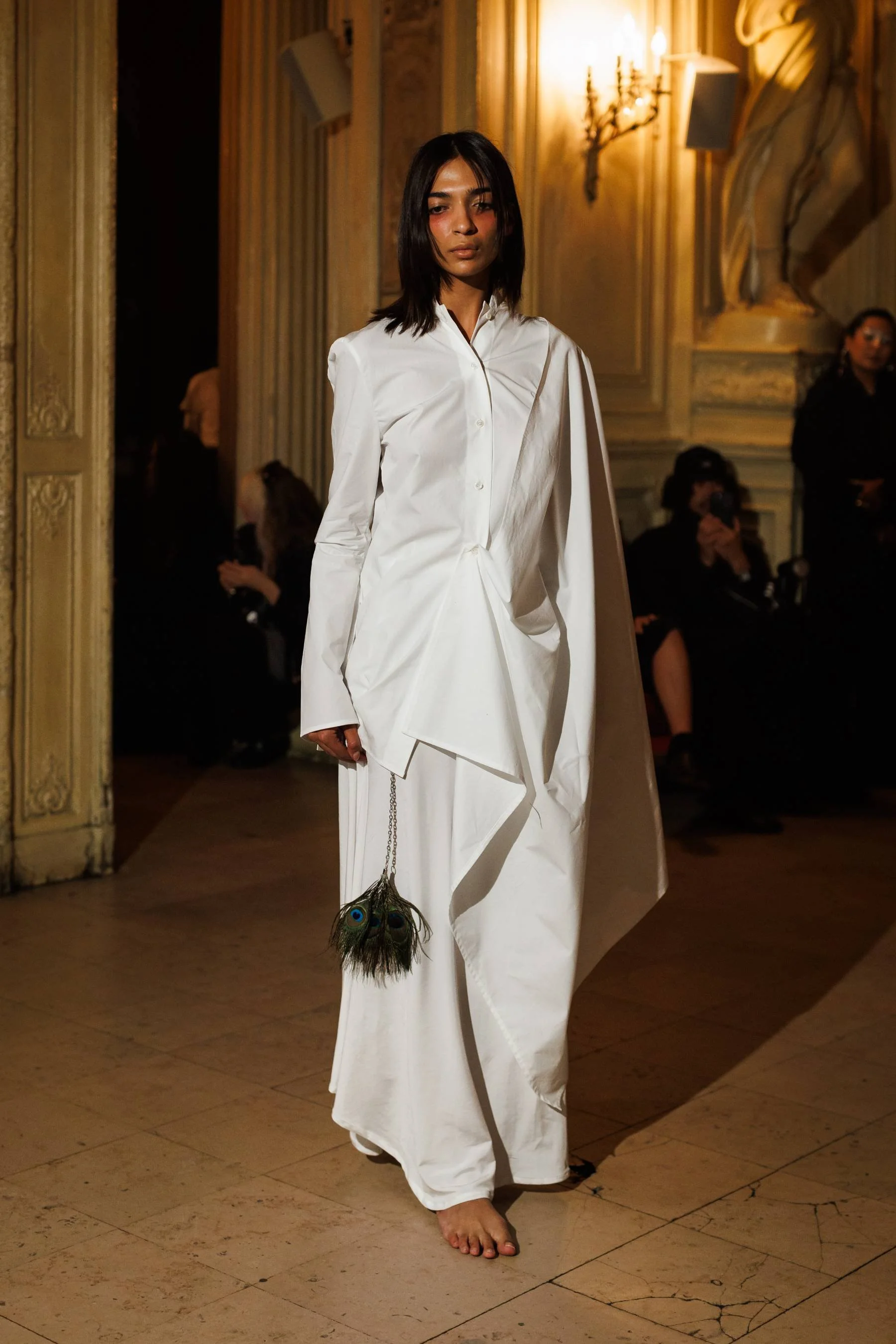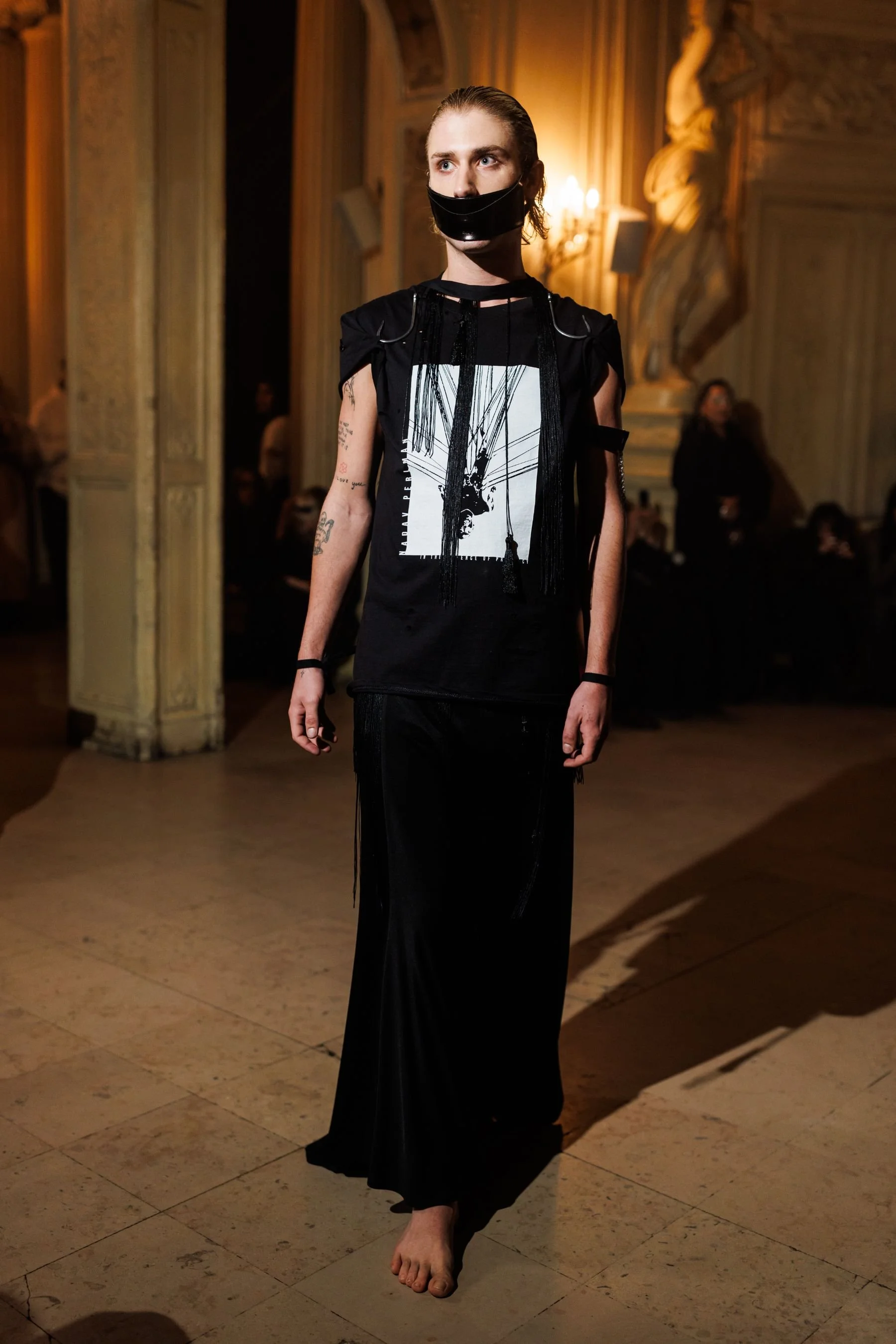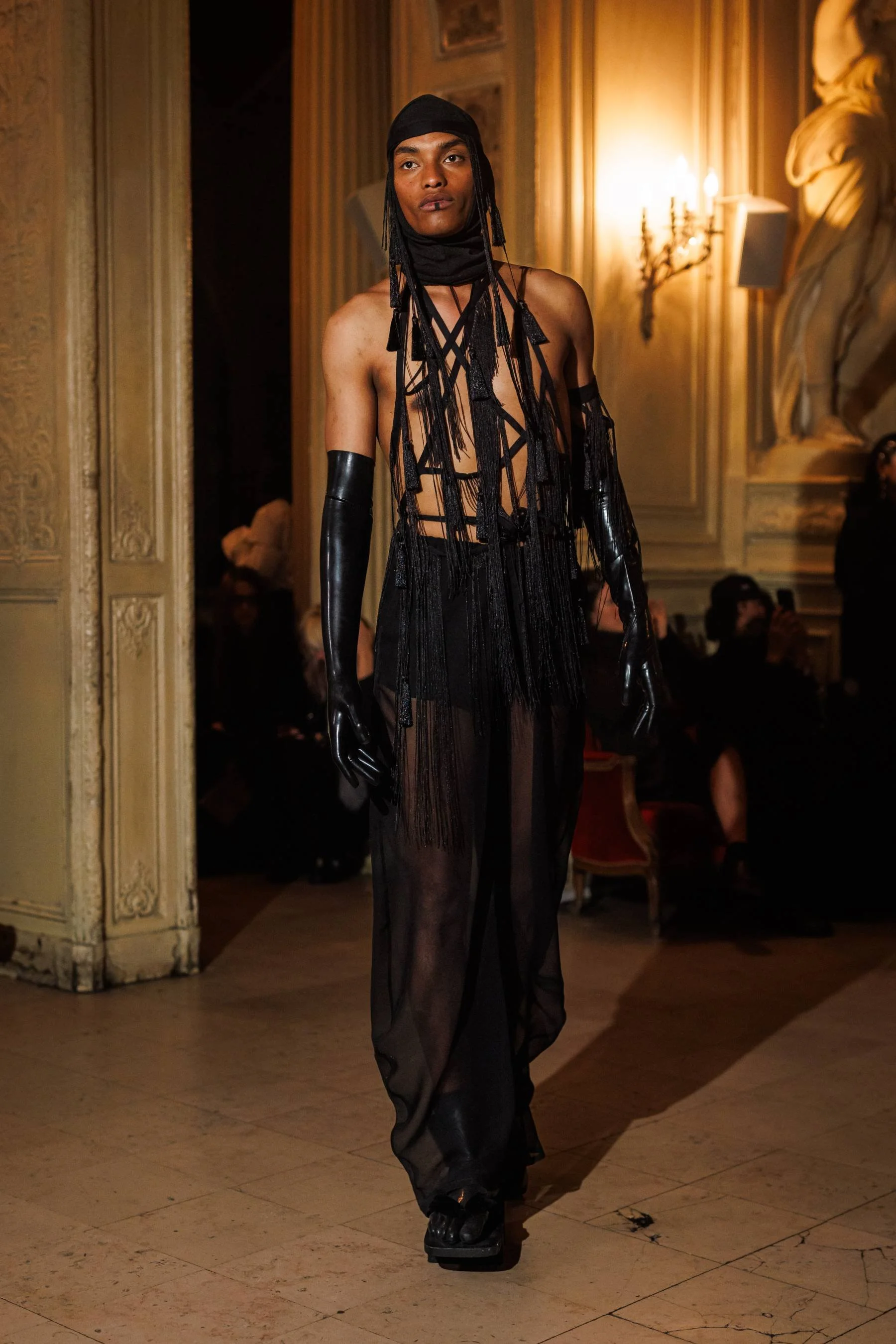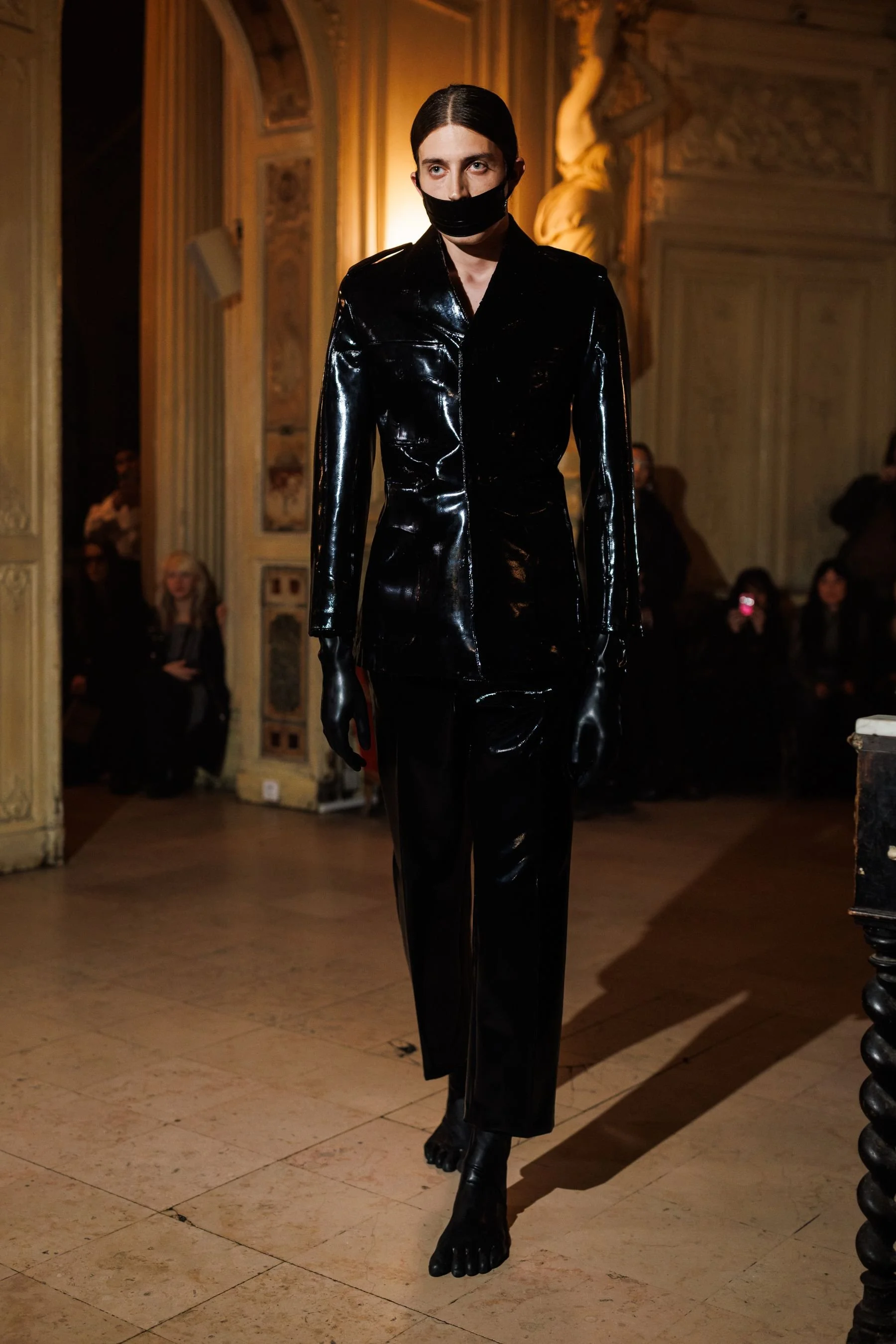Nadav Perlman SS26
Nadav Perlman’s SS26 collection reflects a world in motion, where cities act as crossroads for cultures and traditions. Each garment, performance, and film conveys a dialogue between heritage and contemporary life. The collection interrogates spirituality not as abstract or isolated but as something that permeates daily existence, from the clothes we wear to the rituals we follow.
Suspension, a practice originating in India and the Americas and adopted by modern primitivism in the 1970s, appears in the collection as both a rite of passage and a spiritual pursuit. The artist confronts the tensions of pain and transcendence, examining how struggle may become a source of growth rather than avoidance. This duality mirrors the influence of Jainism, where devotion and austerity inform practice. These apparently contrasting traditions coexist in the collection, connected by a shared intensity that resonates with contemporary experience.
What were the elements that influenced you the most in this collection?
It’s both a reflection of today’s reality and the streets. In Europe, all cultures meet in the cities, and I feel like this is also where the world is heading. That evokes a lot of curiosity about different cultures, their heritage, and their history. What unites us is the fact that we all have spiritual practices, no matter where we come from. This is really what my work is always centered around. It is meant to encourage or inspire an exploration of spirituality in a contemporary context.
Your performance had a very distinct direction. Was it rooted in any specific practice?
The suspension, which is a practice that originated in India and also in the Americas and was later adopted by modern primitivism in the 1970s, is one of those rituals that hold different meanings across cultures. In some, it was a rite of passage, while in others it represented a spiritual search.
In this collection, what was interesting for me was the idea that we live in such a turbulent time, with so much struggle and pain, and I wanted to look at how pain, like the one she experienced during the suspension performance, can be used for the sake of transcendence. How can we move through struggle as a way of growth, rather than trying to escape it?
What she did was really about confronting discomfort and facing shadows. That was one side of it. On the other side, I was inspired by the very pure white dress, particularly from Jainism, which is an Indian religion where monks wear full white or go completely nude. Their initiation rituals are also quite intense and rooted in deep devotion.
In a way, these are two entirely separate practices that might seem to contrast. One comes from a traditional religion, the other from a form of contemporary art culture. But in fact, there is a red thread that connects them. I find it meaningful to show them existing together under the same roof, because this also reflects who we are as people today.
I wanted to ask about the connection to cinematography. Do you relate in any way to sci-fi?
Funny, you are not the first one to mention sci-fi. It is not really part of my direct references, maybe more surrealism than science fiction.
I think when different elements are mixed and expressed through a person, that is when the sci-fi quality can appear. Otherwise, if we talk about other fields, film is probably the most important source of inspiration for me. I feel that creating a fashion collection and making a film are almost the same. You need to build a world that feels convincing, a world the viewer can be fully immersed in. For me, Tarkovsky is number one.
Pasolini and Fassbinder also have a big influence on me, especially through their slow and long films, which inspire the pacing of the performances.
With Tarkovsky or even with The Holy Mountain, you can almost feel that making the film was a spiritual practice. Watching it becomes like entering a deep meditation, a process that transforms you.
This philosophy is something I want to bring into fashion, because I believe fashion also has that capacity to create worlds.
Do you practice meditation yourself?
Yes, I do my best. I think meditation can take many forms. I started with a very formal practice, which I still maintain, formal, traditional, classic, if that makes sense. But once you find that meditative space, it becomes something you can enter anytime; you hold the key, and it becomes yours. Of course, practice is essential, and I am always looking forward to returning to it.
Are there other ways you connect with spirituality?
I think spirituality is really everywhere. That is why fashion is such a good place to explore it, because it touches every part of your life. The clothes you wear, the way you live, how you start your morning, even how you reach for your phone, your relationship with yourself, and the conversations you have with yourself.
What is your connection to technology?
I think technology is incredible in so many ways. I probably would not have had the opportunity to present this collection here if it were not for where we are technologically. I believe people can be influenced and shaped, but at the same time, the world is a crazy place, and we go where it takes us. The best you can do is try to change it while also making sure you engage with everything in a way that feels right to you. How you interact with technology is extremely important.
Where do you see yourself and your work in the next two, three, or even five years?
I can tell you where I want to go. For me, the main goal is to spark conversations around spirituality and bring this topic to the table as much as possible. I also want to spread the word and share the clothes as widely as they can reach. I hope to create more moments like this, where people can witness something that makes them think and ask questions. And of course, I would love to see people wearing my clothes. That is really the dream.
Regarding your community and the message you want to share, do you aim to create something beyond the brand? Are you also interested in building a space or platform where people can engage with something connected to spiritual practice?
The brand focuses on fashion collections, but performance and film are always part of the practice. We are already branching into these two areas. As I mentioned, film is extremely important, and we have already created several films with the company. Performance art is also always part of what we do. For me, the goal is to expand in these areas and to be able to multitask more effectively. As the team grows, I hope we can explore even more possibilities.
Creating a dedicated space would be amazing. Ideally, I would like my shop to function as a meditation venue as well. I feel that today, spirituality often comes with a certain aesthetic, which can make it harder for some people to relate to. I would love to offer a different perspective and invite people to experience it. For example, just like this space served as a place for meditation, it is up to each person how they engage with it, whether they witness it through their phone or with their eyes, whether they connect or not.


























